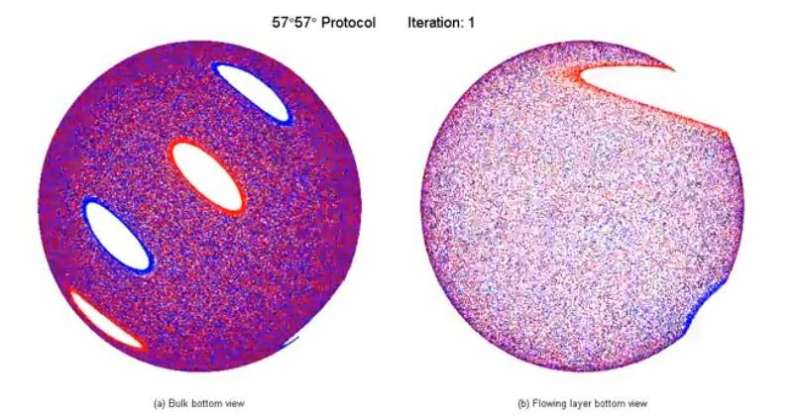When mixing granular matter, order among disorder

Mixing liquids is easy, or at least scientifically understood: a drop of food coloring will eventually mix into a cup of water through diffusion, and a dollop of cream can be mixed into coffee with a spoon through what is called turbulent mixing.
But what if the material has the properties of both liquids and solids, which is the case for materials like concrete, paint, and sand? Called yield stress materials, these mixtures can both flow like liquids and remain still like solids.
Understanding how these materials mix has implications in industries such as pharmaceuticals and concrete manufacturing, but little is still known about how to best mix them.
In a new paper in Nature Communications, Northwestern Engineering professors find that mixing yield stress materials creates both mixed and non-mixed regions, providing a fundamental beginning to understanding how to best design mixing protocols. Julio M. Ottino, Paul Umbanhowar, and Richard Lueptow served as the paper's co-authors.
"The theoretical foundations of flow of granular matter are still very incomplete," said Ottino, Walter P. Murphy Professor of Chemical and Biological Engineering. "We found remarkable persistence of order amid chaos."
In question was how well granular material could be mixed in a basic system: a spherical tumbler. Would the material mix like a solid, through a "cutting-and-shuffling" method similar to a deck of cards? Or would it mix like a viscous liquid, like honey, through a "stretching-and-folding" pattern?
To test this idea, the researchers half-filled a spherical tumbler with 2 millimeter-sized glass beads. When rotated, the top layer of beads flowed like a fluid down to the bottom of the sphere, while the other beads remained in place, like a solid.
But researchers mixed the beads by rotating the tumbler along different axes. To track how well the beads mixed, they placed a 4 mm tracer particle inside and then ran the rotations over and over, sometimes up to 500 times, and took X-ray images of the sphere to see where the tracer particle ended up.
Despite trying several different rotational protocols, the researchers found that there were inevitably regions that mixed and regions that did not mix. This was the result of the interplay between the two mixing methods, cutting-and-shuffling and stretching-and-folding.
"Even though the material often moves in wedges in this cutting-and-shuffling manner, all those wedges do is move around together," said Umbanhowar, research professor of mechanical engineering. "There are regions that never get mixed."
Understanding this concept may lead to insights in interesting and unexpected places, such as the Spanish Christmas Lottery, where 100,000 small wooden balls with unique ticket numbers are tumbled in one sphere, while 1,807 balls labeled with prizes are tumbled in another. During the drawing, one prize ball and one corresponding ticket number are plucked from each sphere until the prize ball sphere is empty. But if the tumbler includes regions that are mixed and regions that aren't, the ball's initial placement in the tumbler becomes an outsized factor in whether it will be chosen.
"There is an expectation of randomness, but our results show that this is not the case," Ottino said.
The researchers hope to conduct future studies to show how this information can be applied across different materials.
"This gives us a whole new tool to understand what mixes and what doesn't mix," Umbanhowar said. "These results can ultimately be used as a design tool."
More information: Zafir Zaman et al. Persistent structures in a three-dimensional dynamical system with flowing and non-flowing regions, Nature Communications (2018). DOI: 10.1038/s41467-018-05508-7
Journal information: Nature Communications
Provided by Northwestern University



















